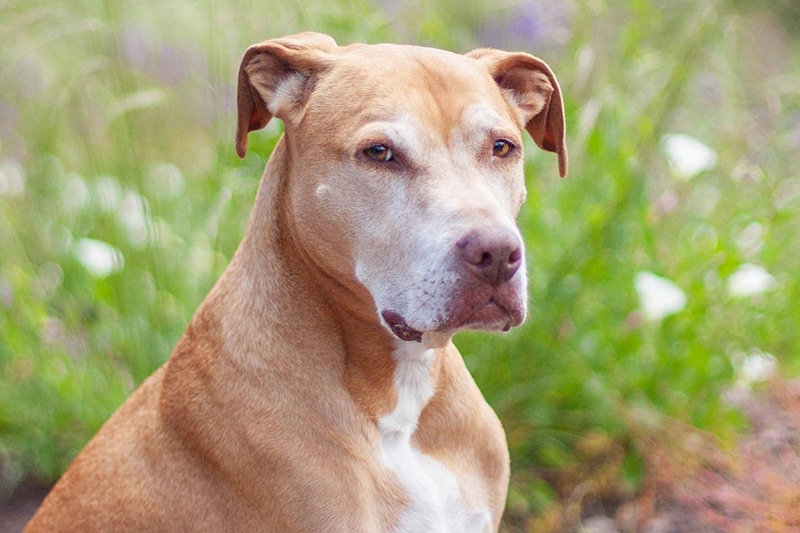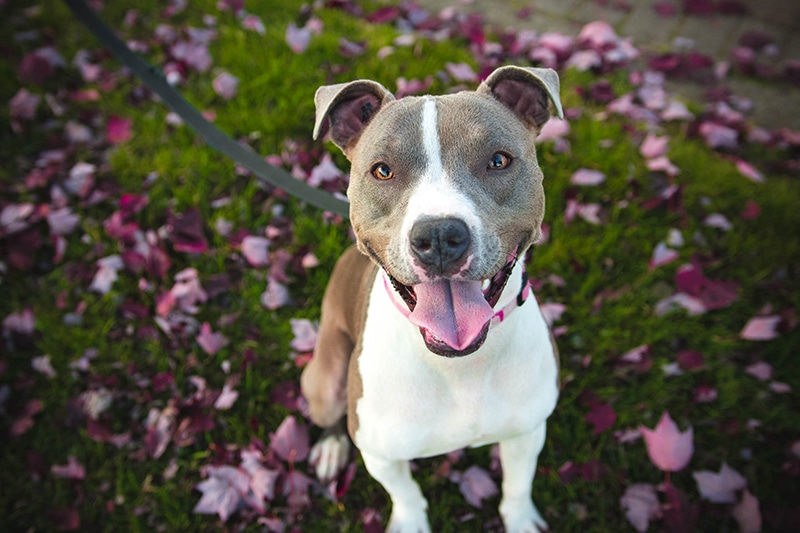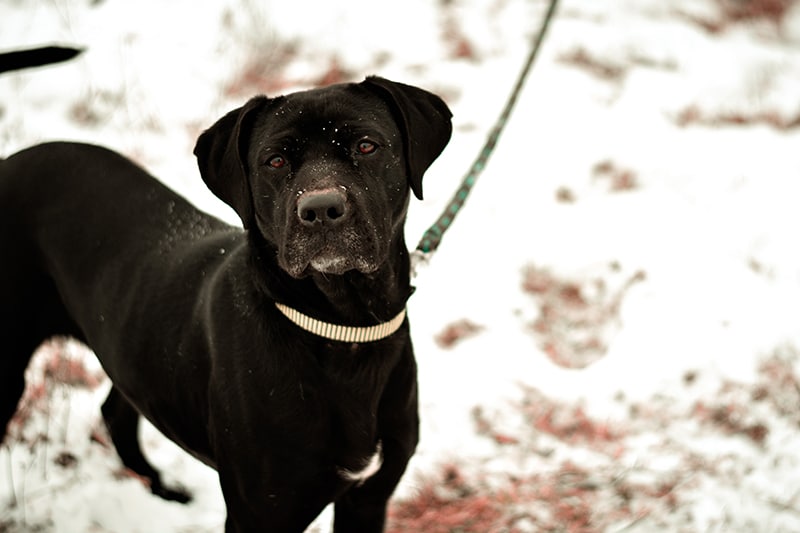The Akita Pitbull mix, also known as the Akita Pit, is a medium-sized mixed-breed dog created by crossbreeding an American Pit Bull Terrier and a Japanese Akita. Despite the Akita Pitbull mix being relatively new, the Akita Pit has gained steadily in popularity over the years.
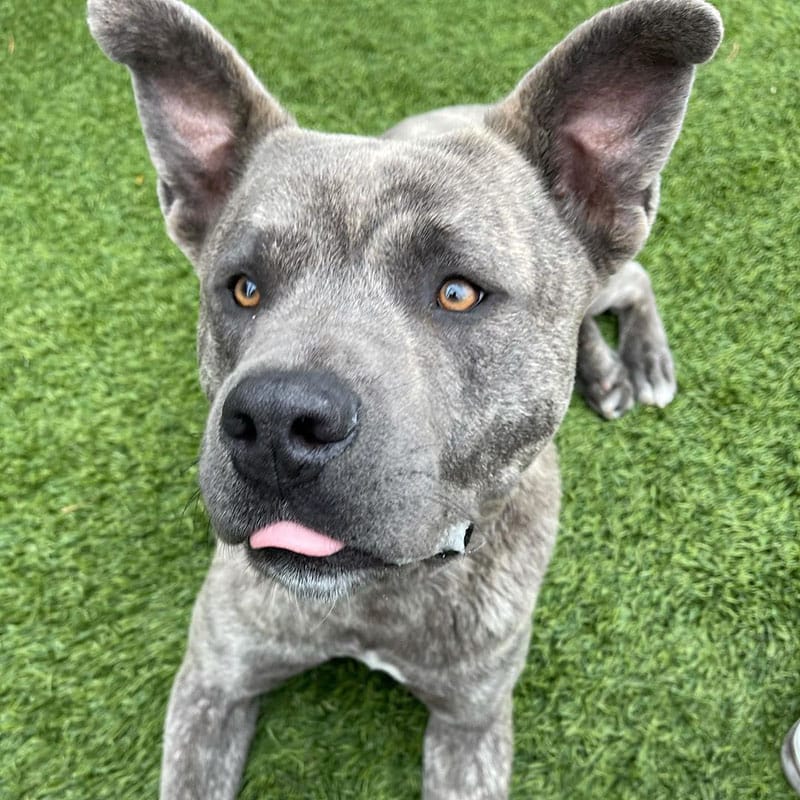
To learn more about the Akita Pit, we’re going to explore the histories, temperaments, popularity, and more of both parent breeds to better inform you about what to expect from your Akita Pitbull mix.
Pitbull Akita Mix – At a Glance
| Weight: | 30 – 70 pounds |
| Height: | 16 – 23 inches |
| Lifespan: | 10 – 12 years |
| Coat Colors: | Tan, cream, brown, white, black |
| Temperament: | Loyal, enthusiastic, active, stubborn |
| Most Suitable For: | Families with or without children, active single individuals |
What Does a Pitbull Akita Mix Look Like?
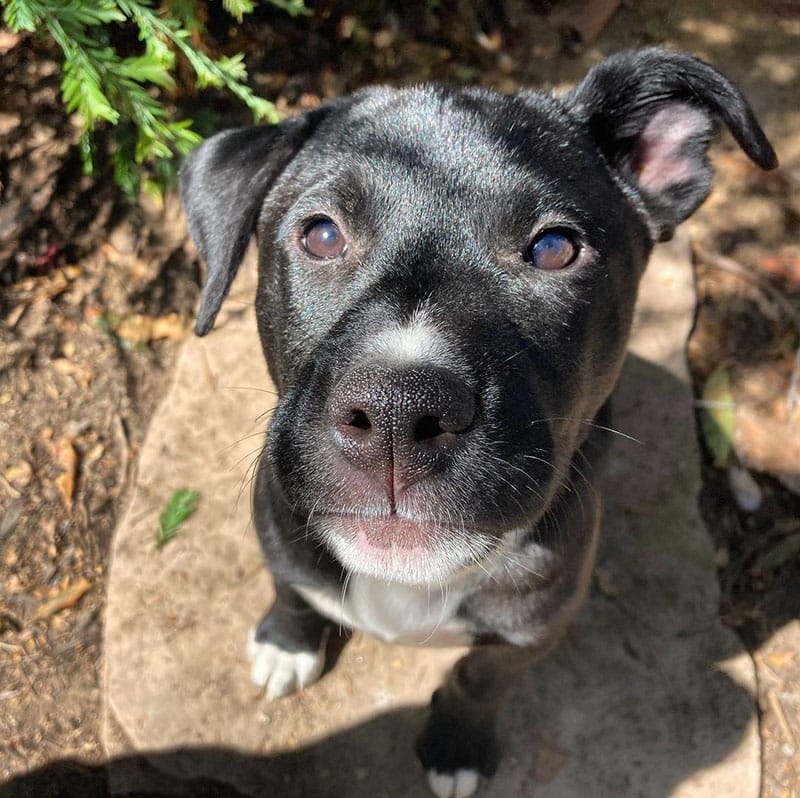
The appearance of an Akita Pitbull mix will be highly impacted by both parent dogs – as is the case with most designer dogs. Your Akita Pit will likely inherit the overall size of the Pitbull, with an elongated body. It may inherit the upright ears of the Akita or the forward-folded triangular ears of the Pitbull.
The Akita’s physical presence will be most obvious in its larger frame than a traditionally-sized American Pit Bull Terrier. It could also adopt the traditional tan coat of the Akita, but it may also have a mix of colors. It’s also likely that your Akita Pit will have a double coat, like the Akita.
As with most designer breed dogs, their exact physical appearance is difficult to predict, it all depends on how the genes shake out during development.
Are you looking for a way to treat your furry friend? Sign up for our newsletter for a chance to win a free month of Barkbox!
The History of the Pitbull Akita Mix
The Pitbull Akita hasn’t been around for more than twenty years. In the 1990s and early 2000s, crossbreeding dogs of all stripes became very popular in the United States, and this likely is when the Akita Pit Bull first appeared.
To learn more about the history of the Akita Pitbull mix, we will explore the history of their parent breeds in detail. Learning about where each parent dog came from, including how popular they are today – and who they’re suitable dogs for – will give us (and hopefully you) a better understanding of how the Akita Pitbull mix came to be.
The History of the Akita
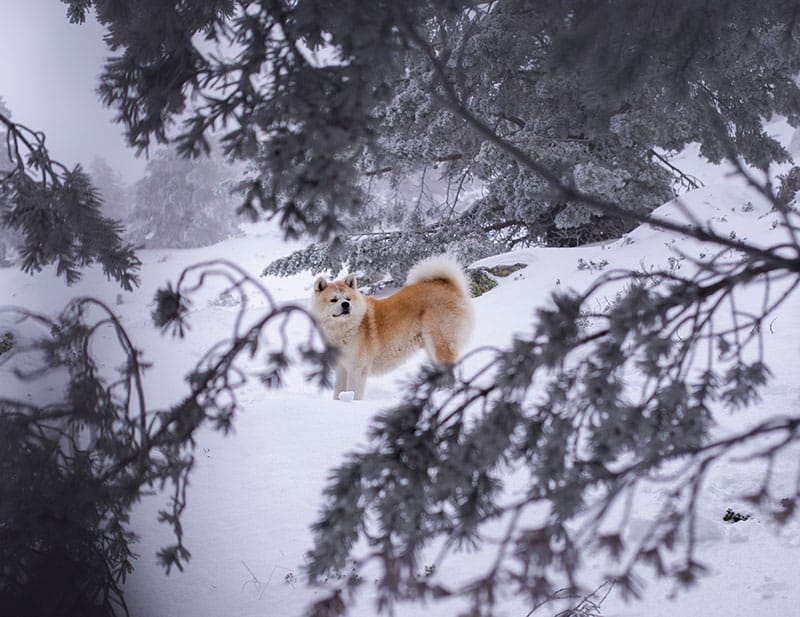
The Akita, or Akita Inu, is one of Japan’s oldest and most popular dogs. Their exact dates of origin are unknown. However, they did serve the samurai from the 16th to the 19th century. Beyond loyal service to the samurai as guard dogs and companion dogs, Akitas were known as working dogs in the mountainous region of Odate, Japan. Initially bred for hunting wild boar, and Ussuri brown bears, their dense coats were well-suited for chillier weather.
Over time, the Japanese Akita became a national treasure and was officially a Japanese natural monument in 1931, with efforts to preserve the original Akita Inu bloodline by the mayor of Odate.
In 1937, Helen Keller traveled to Japan and grew an immense fondness for the Akita. She was presented by the Japanese emperor with two Akitas to bring into the United States. This would be the first time that the breed was introduced into the American canine landscape.
How Popular Are Akitas in the United States?
Since 1937, Akitas have maintained relative popularity within the United States and even fostered a brand-new breed – the American Akita. While the exact crossbreed is lost to history, the America Akita has a few key differences from the Japanese Akita. Notably head shape, ear length, muzzle, and coat coloration. Japanese Akitas are a mostly solid tan color. Meanwhile, American Akitas come in a variety of colors.
American Akitas and Japanese are recognized as two separate breeds by the American Kennel Club. However, their popularity is measured under the singular “Akita” name. In 2021, Akitas ranked as the 52nd most popular dog in the United States.
Who Are Akitas a Good Dog For?
Akitas are large-sized dogs with double coats and a strong, powerful body type. They require regular exercise and like to be taken on daily walks, along with sufficient mental stimulation. Given their size, they’re unsuitable for apartment-dwellers and fare much better with a house and yard.
Their need for physical activity doesn’t make them compatible with most elderly owners or those without the time for the hour-long walk needed to quell their energy level.
How Did Akitas Come About?
The Akita Inu is a dog of Japanese origin that was originally bred sometime before the 16th century, in Odate, in the Akita Prefecture of feudal Japan. They were originally used as hunting dogs, then guard dogs for samurai and the emperor.
Their immense popularity in Japan led to them being the nation’s favorite and national monument. In 1937, two Akitas were transferred to the United States by Helen Keller, who was gifted them by the people of Japan.
When Did We First Cross-Breed The Akita?
The Japanese Akita is a popular crossbreed due to their friendly and energetic nature. During the Second World War, the Japanese owners of Akitas were ordered to hand their dogs to the State to be culled as they were “non-military dogs,” unlike the German Shepherd. Some Japanese farmers bred their Akitas with German Shepherds to preserve the breed. This was one of the first instances of widespread crossbreeding of the Akita in Japan.
Modern-day crossbreeding of Akitas has led to several popular mixed-breed Akitas, including
- Akita German Shepherd Mix (Shepkita)
- Corgi Akita Mix (Corkita)
- Akita Cane Corso Mix (Corso Akita)
- Akita Golden Retriever Mix (Golden Akita)
- Akita Pug Mix (Pugita)
The History of the Pitbull
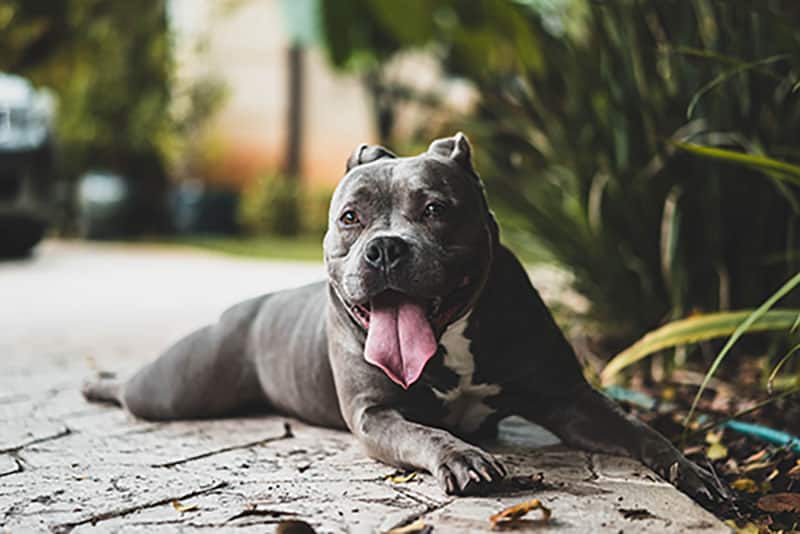
The history of the Pitbull stretches back centuries. Originally bred in the early 19th century from the Olde English Bulldog and Old English Terrier, the breed was used as a ‘bull-baiting’ breed, along with the Boxer and other terrier-type dogs.
Despite this English origin, the modern American Pit Bull Terrier has its roots in Pitbulls that were transported to the United States sometime between 1840 and 1860, following the breed’s fall from favor in the United Kingdom. This is largely due to the fact that the ‘bull-baiting’ blood sport, for which the Pitbull had been so popular was made illegal in 1835.
It was brought to the New World to save the breed from extinction. As the years progressed, the American Pit Bull Terrier was used in dog fighting and rat-catching capacities, though with the outlawing of those practices, they became useful companion pets, police dogs and used in a military capacity.
Unfortunately, the Pitbull has been made illegal to own in many American cities due to their history and capacity of aggression and violence towards smaller dogs and other small animals.
How Popular Are Pitbulls in the United States?
Pitbulls have a murky legal status in the United States that makes it difficult to track their popularity accurately. They are unrecognized by the American Kennel Club. At present, only the United Kennel Club recognizes the American Pit Bull Terrier as a legitimate dog breed – unfortunately, they keep no population statistics.
However, other sources indicate that Pit Bulls account for 20% of America’s ‘strong’ dog breed ownership.
Who Are Pitbulls a Good Dog For?
Pitbulls are powerful animals with broad chests, muscular shoulders, and legs. They tend to be of average weight, but their strength makes unsuitable for those without the physical presence to control them on walks.
Pitbulls also don’t do well in small environments, such as an apartment, and need a house & yard to flourish. Given their moderate energy levels, this powerful breed will require about 45 minutes of exercise per day. They’re also a fairly low-maintenance breed, being single-coated and low-shedding.
Pitbulls make great family dogs. However, beware of leaving them alone with cats and other smaller animals, as Pitbulls have been known to display aggressive behavior and even kill them.
How Did Pitbulls Come About?
The Pit Bull Terrier was originally bred in England in the 19th century from the Old English Bulldog and the Old English Terrier – known today as the English White Terrier. A hybrid dog breed in its own right, Pit Bulls were mostly used for dog fighting and ‘bull-baiting,” a brutal sport where Pit Bulls and other terrier-type breeds were placed into a pen with an angry bull cow and ran till either they collapsed or the dog was killed.
This brutal practice was outlawed in 1835 and Pitbulls have been steadily re-gaining their popularity in the New World since then.
When Did We First Cross-Breed The Pitbull?
Given the Pit Bulls’ murky legal status in the United States and much of the West, it’s not uncommon to find Pit Bull mixes that circumvent those restrictions. The American Pit Bull has likely been crossed with many different types of dog during its life in the United States, but modern crossbreeding began in earnest in the 1990s and early 2000s.
Since then, some of the most popular Pit Bull crossbreeds include:
- Pitbull Blue Heeler Mix (Pit Heeler)
- Pitbull Catahoula Mix (Pitahoula)
- Pitbull Corgi Mix (Corgi Pit)
- Pitbull Dalmatian Mix (Pitmatian)
- Pitbull Great Dane Mix (Great Danebull)
How Important Is a Dog’s Temperament to Your Family?
One of the most important things in your relationship with your dog is the activities you share with them. To that end, you’re likely going to look for a dog that fits best within your existing family unit. To do this, you’ll want to conduct extensive research on the temperaments of each different dog breed you’re considering.
If you have children, then a large dog like a Great Dane, or a Mastiff might be too big and could cause a tripping hazard for the kids, if the dog were to accidentally bungle into them. Likewise, if you’re an outdoorsy family, then you’re going to want a dog that has an active and outgoing temperament.
If you’re more homely and active indoors, then finding a pet that can doesn’t mind being indoors is critical. A Siberian Husky won’t do well in an apartment, for example. Meanwhile, a Pug is a fine family pet, but ain’t no farm dog.
Choose your dog breed wisely!
What is the Temperament of the Pitbull Akita Mix?
Like most designer dogs, the Akita Pitbull Mix will inherit different parts of its temperament from both parent dogs. Thanks to the Pit Bull genes, this will result in an active, energetic breed with potentially slight hyperactivity.
You can expect your Akita Pit to be an affectionate animal, with plenty of love and time for it’s owners. It may be slightly standoffish with strangers, however. You might also notice that your Akita Pitbull mix suffers from separation anxiety, this is common among Pit Bull Terriers and can often result in destructive behavior.
If you notice that your Pitbull Akita mix is displaying destructive behavior while you’re not home, be sure to invest in extensive training right away. With proper training, the destructive behavior will stop.
Otherwise, you can expect your Akita Pitbull mix to be an excellent family pet.
Is The Pitbull Akita Mix Friendly?
In general, you can expect your Akita Pitbull to be a very friendly animal, with slight standoffishness around strangers. Towards other animals, the Akita Pit is likely to be fine with dogs around the same size as it. However, it may display aggression towards other, smaller animals such as cats.
Is The Pitbull Akita Mix Easy to Train?
You may initially experience some difficulties training the Akita Pitbull mix, mostly due to the Akita’s stubbornness. You’ll eventually break through that stubborn exterior with ongoing training and using positive reinforcement techniques.
How Much Can A Pitbull Akita Mix Weigh?
Being a medium-sized dog, you can expect your Akita Pitbull mix to weigh between 30 and 70 pounds.
How Tall Can A Pitbull Akita Mix Get?
You can expect your Akita Pitbull mix to reach an average height of 16 to 23 inches tall.
Similar-Sized Breeds
There are a few similar-sized breeds to the Akita Pitbull mix. These include:
- Boxer
- Chow Chow
- English Shepherd
- Golden Retriever
Does the Pitbull Akita Mix Shed?
Your Pitbull Akita will likely have a double coat. Still, it will be dense and short-haired, meaning it’ll likely shed moderately throughout the year but won’t experience the traditional ‘blowout’ of many other double-coated dogs.
How Much Exercise Does A Pitbull Akita Mix Require?
The Pitbull Akita mix is likely going to be a moderately energetic dog. This means you should expect to walk your Pitbull Akita for around 45 minutes daily. Along with other games that give them mental stimulation. This is one of the reasons why Pitbull Akitas fare better with a house & yard.
How Long Can a Pitbull Akita Mix Live?
The average lifespan of a Pitbull Akita mix is 10 to 12 years.
What Health Conditions Could the Pitbull Akita Mix Have?
- Progressive Retinal Atrophy (Eye condition)
- Hip Dysplasia (Hip joint inflammation)
- Patellar Luxation (Kneecap dislocation)
- Hypothyroidism (Metabolism issues)
How Can You Find a Pitbull Akita Mix Puppy For Sale?
Before you start searching for a Pitbull Akita mix puppy for sale, we instead recommend that you try to find an adorable companion via adoption. Due to the murky legal nature of Pitbulls, the overall exercise requirements and size of the Akita Pit, it’s highly likely that you’ll find an Akita Pit up for adoption at your local vet clinic or animal shelter.
If you strike out with the vet clinic or animal shelter, try searching online for an Akita Pit in your area at AdoptAPet.com.
How Much Does a Pitbull Akita Mix Puppy Cost?
The average cost of a Pitbull Akita mix puppy is around $250 to $500 per pup. While not an outrageous price tag by any means, the cost is still higher than trying to adopt an Akita Pit.
If you still prefer to purchase an Akita Pit, you can search for a reputable breeder. If you’re unsure where to start, read our guide to finding the best designer breeder.
Is the Pitbull Akita Mix the Right Breed For You?
If you’ve been looking for an exercise or hiking companion, the stocky, muscular and agile Pitbull Akita mix might be the right breed for you! Equal parts active pet and lovable cuddle-monster, this sweet medium-sized dog is perfect for a family with older children, or a single individual looking for that motivation to get outside.
If, however, you’re not sold on the idea of a Pitbull Akita, we’ve prepared dozens of other breed guides, to help you select the best breed for you.

